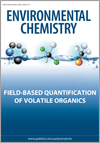EN19270Novel metabolomic method to assess the effect-based removal efficiency of advanced wastewater treatment techniques
 , Malin Nording, Richard Lindberg, Tomas Brodin, Stina Jansson, Jun Yang, Debin Wan, Bruce Hammock and Jerker Fick
, Malin Nording, Richard Lindberg, Tomas Brodin, Stina Jansson, Jun Yang, Debin Wan, Bruce Hammock and Jerker Fick
Environmental context. Advanced wastewater treatment is required to remove pharmaceuticals and many other consumer chemicals from wastewater effluent. There are conflicting findings, however, on the toxicity of treated effluent, and its effect on living organisms is often neglected. We show that the effect-based removal efficiency of wastewater treatment technologies can be assessed by metabolomic methods, and that this approach contributes to a safer and more controlled water quality.
EN19270 Abstract | EN19270 Full Text | EN19270PDF (331 KB) | EN19270Supplementary Material (422 KB) Open Access Article




